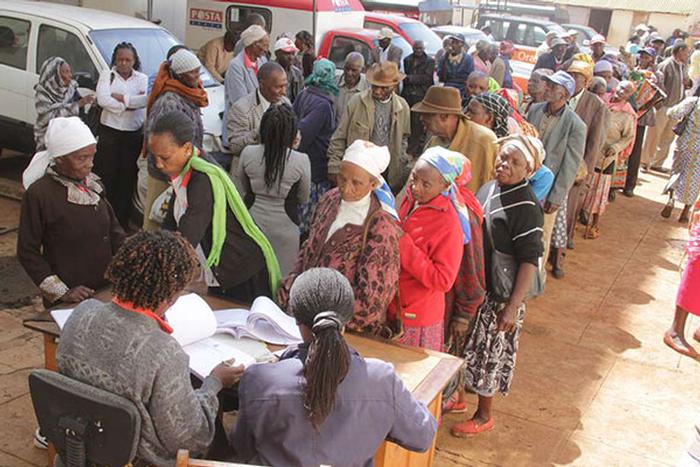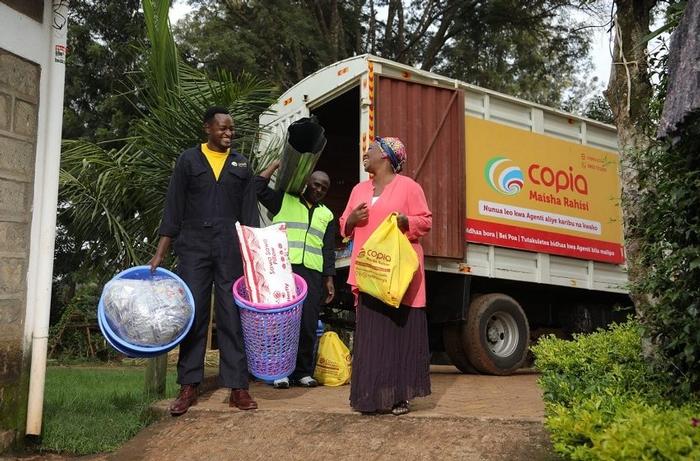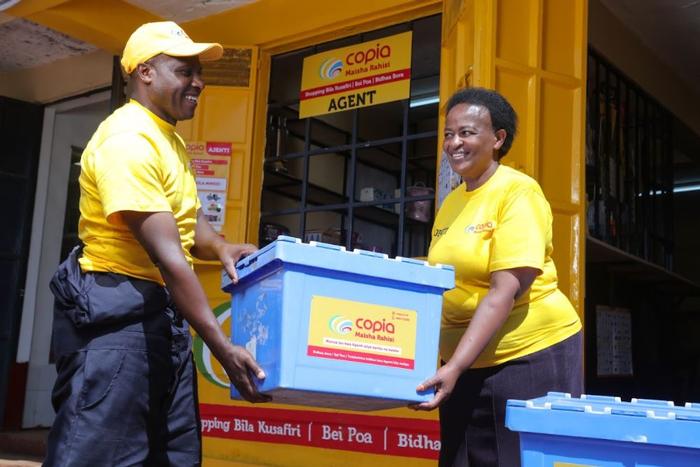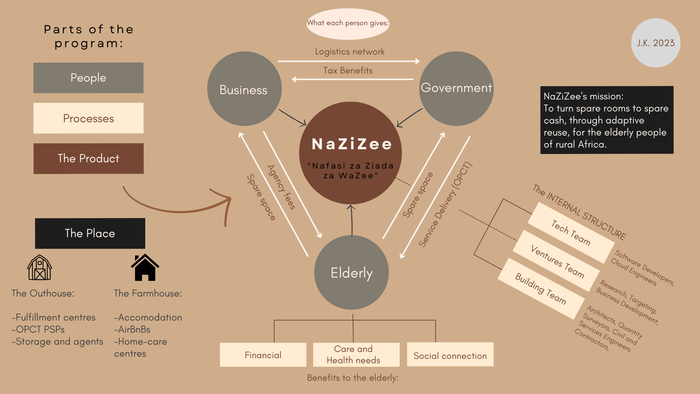Jerome Kimani - Essay
FROM SPARE ROOM TO SPARE CHANGE: Adaptive reuse for economic revitalization of homesteads in Rural Africa.
Nearly five months ago during a trying time for my family, I travelled to our ancestral village in Murang’a, central Kenya to stay with my now-widowed grandmother for a week. This gave me a first-hand account of the plight of her financial state. She was now fully dependent on money being sent as remittances to her by her children, a far cry from the sprightly self-sufficient farmer that she was some years before.
Across Africa, the youthful African population has flocked to urban centres for opportunities. They leave behind their parents and grandparents who have resorted to retire upcountry. These retirees engage in crop farming and animal husbandry and live off their produce. Gradually, through illness and complications caused by ageing, their productivity declines and their mobility reduces.
For these people, much of their wealth is held unproductively in non-liquid assets such as land. They have a pressing need for a consistent supply of money in cash to offset recurring expenses.
Despite being predominantly reliant on financial support due to their care-related needs, senior citizens also crave a sense of agency and self-dependence that comes with them living at their own home. Additionally, in Africa, it is almost taboo to mention of sending a relative to a nursing home, as this is seen as a rejection by your family. How then can we balance these two realities using a design solution?
The answer lies in the spaces left behind. These include spare bedrooms that were left when children long since moved out, empty granaries, food stores and animal pens. These unoccupied, derelict spaces seem to be a common factor in many households where younger generations have moved to urban centres. How can these spaces be adapted for income-generating activities?
Through adaptive reuse, the left-over space in the homes of senior citizens could be adapted for different ventures with business models which are attempting to increase their rural footprint with remote services as well as government service delivery.
What would it take for this to be possible?
The answer lies in the title: We need to focus on the spare rooms, the value additive processes that can evolve them to into spare change, and the people in between who can make this happen.
From this, the following three clusters need to be considered: The Place, the People and as a result The Product.
The Place is the physical space that would be the three dimensional extents within which this project takes on its life. This is arguably the most important factor in this project given that its success is predicated on a design solution. This is where the architects offer their value to this community, by answering the question; “Where will this happen?.
The People are the different stakeholders who need to work together for the project to be successful. The project would need to address a pain point for each of the parties working together to consider it a viable project. On all counts, one needs to answer the frequently asked question; What is in it for us?
The Product concerns the form that the offering would take in order to be considered a feasible endeavor. Given that this is an initiative that is a design solution for a financial benefit, you could interrogate it using the question; What is the business case?
We shall interrogate the three elements by;
- analysing the existing synergies that can be leveraged
- envisioning ideal solutions, and
- interrogating the risks and gaps that that would need to be addressed for this project to become a reality.
THE PLACE.
What is the opportunity for adaptive reuse of spare rooms in homesteads in rural areas? To answer, let us first direct our attention to our demographic of interest: the elderly. According to an Audit of residential institutions for elderly persons conducted in Kenya by the National Gender and Equality Commission, urbanization and changing value system has meant majority of the young people have left their parents homes in rural areas in search of better lives.
Next, we shall need to develop an understanding of the prevalent spatial arrangements.
Rural Kenya comprises mostly of an agricultural land use. The agricultural sector employs over 40 percent of the population and more than 70 percent of the rural populace according to the Central Bank of Kenya. George Rapsomanikis of the Food and Agriculture Organization of the United Nations affirms that Kenyan smallholder farmers on average farm 0.47 hectares (roughly 1.2 acres) and although most of them live in poor conditions, they live in their own dwellings.
For these smallholder farmers including these the elderly, we can group the buildings on their land into two separate typologies: the dwelling spaces or farmhouses, and the outhouse spaces or barns. The spare rooms in the dwelling spaces are mostly internal spaces, like bedrooms and store rooms, which are private and directly in contact with the the elderly involved. The outhouse spaces are those which facilitate farming activities which are more public spaces and include animal pens, granaries and grain stores.
Ideal Solutions.
Having defined these two typologies of place: farmhouse and outhouse, we can now analyse ideal solutions that would be made possible through the transformation by adaptive reuse.
-Farmhouse: Due to safety reasons, the most apparent application would be accommodation spaces. There is an ever-growing societal acceptance of sharing residential spaces since the advent of room-sharing platforms like AirBnB. In an African setting, where the welcoming culture and willingness to accept guests in the spirit of humanity that we call Ubuntu, is hardly a novel idea.
Converted spare rooms could be used by people who do not need elaborate accommodation and would love a local cultural twist. This could open up these rooms to use by those who wish to explore remote rural areas, students on work study and community-service camps, and even travellers who require lodging facilities.
-Outhouse: These spaces are more apt for commercial applications. A primary commercial concern that would be solved is temporary storage for business stock. Additionally, startups and large growing businesses which continue to proliferate the rural areas are constantly looking for asset-light solutions for functions such as fulfillment centres, which would offer a small-scale solution for these companies to deliver their orders and then have them sorted before final delivery.
Potential risks and further investigation.
In order for this to work, one would have to figure out the space requirements and answer the following questions:
- Distribution- How many houses exist with such possibilities which parts of rural Kenya?
- Safety- How can safety of the elder persons be ensured through spatial intervention?
- Materials and technology- are locally-sourced materials more feasible or is there a need to create a standard tried and tested solution that can be imposed on all sites with minimal modification
- Function- how can multiple functions be spatially-enabled in order to serve the needs of elderly persons and their care? e.g. outpatient clinics, relief collection centres.
THE PEOPLE.
Who are involved in this process and what is in it for them? The main people that would be involved are in three groups: elderly persons and their families, the government, and businesses.
In the Kenyan setting, the government are no strangers to the needs of elderly persons , and there exists a system that can be leveraged to address the plight of the elderly. This is the Older Persons Cash Transfer program (OPCT) which was launched in 2007 under an initiative known as Inua Jamii (translated as: uplift the community) by the Ministry of Labour Social Protection.
The OPCT is a program that targets people over 65 years of age who are poor and vulnerable and offers cash disbursement to cushion their households from income-threatening risks.
An audit of the management of this program done by the Auditor General of the country in 2018 gave an insight as to one of the spatial elements that was hindering the disbursement of the cash payments: distance to pay points. The audit noted that 86% of the OPCT beneficiaries sampled were travelling further than the stipulated distance of 6 Km to Payment Service Provider (PSP) points, which were in the form of national bank branches, payment agents and mobile banking stations often found in town centres. The biggest problem that this presents is the safety of beneficiaries who travelled to receive disbursements, particularly on dates of payment were announced publicly.
This introduces the third stakeholder: Businesses. There exists an opportunity to take advantage of proliferation of ventures that are taking consumer services to the heart of rural communities.
By way of example, take a venture-backed startup such as Copia Global, which delivers retail goods on order to retailers upcountry. All of this through convenient, user-friendly mobile commerce.
A business like this already have an agency model that works with local residents at their spaces.
Furthermore, according to their website, as of the beginning of the year 2023, Copia Global have gone even further with their mission to make commodities accessible to underserved rural communities through enabling doorstep deliveries of their retail goods direct to the consumer. This means that accessing rural homesteads and interacting with people is already well within their plans of growth.
Ideal solutions,
What’s in it for everyone? Assuming the understanding of place makes sense under the two typologies described above, the stage is set for a partnership between these three people.
These spare spaces within the homesteads of senior citizens could be retrofitted into different use cases. This especially applies for what is referred to as the outhouse typology above.
The Government Gets: Enhanced Service Delivery
Through creation of Payment Service Points, the government is able to make sure that disbursements can be made closer to the households intended recipients of this OPCT program. Additionally, they have a greater opportunity for service delivery by having such a close connection with the elderly and consequently their families.
By taking government services to them, instead of having them travel for it, they can track and plan for different needs for service delivery to a very small jurisdiction level such as healthcare services, energy needs, and even relief food and aid.
The Businesses Get : Better Customer Success
These businesses and a range of others will get points of contact that are closer to their target consumers. Whether through employing these people as agents or taking up these spaces as stores or fulfillment centres as described above, they have a wider footprint that offers a greater connectivity for their supply chain and source of crucial and timely data that can affect their decisions and make them more profitable.
They also serve an underserved group of people and this can offer an opportunity to negotiate incentives from government such as waivers and tax benefits.
The Elderly Get: Proximity to Care
Through this partnership, the elderly stand to benefit the most.
Financially, through the agency model that businesses such as Copia employ, they can receive agent fees, and Copia boasts more than 30% increased income directly to their accounts.
Their physical health stands to benefit as well, because they have a closer distance to essential services while at the same time being moderately productive and doing minimal manual labour.
Their psychological well-being is taken care of by maintaining a social connection to the community, through regular visits for goods and services.
Potential risks and further investigation.
In order for this to work, one would have to figure out the demographic requirements and answer the following questions:
- Elderly persons- What should be done of those who do not have such spaces, how can they be brought as close as possible to these service-delivery spaces?
- Government- How many people are registered on the OPCT program that have available spaces in their households?
- Businesses- What are the current logistical footprints of such rural-centric businesses? What are their rural expansion plans that can be leveraged?
- Other players- Are there opportunities for other interested parties to fit in like Non-Governmental Institutions and Developmental Finance Institutions? Do they fit the classification of Business or Government, and how do they benefit?
THE PRODUCT.
How do we get the spare change? Finally, we shall explore the value additive process that has come out of this public private partnership that aims to benefit elderly persons.
In terms of already existing product synergies between the government and rural-centric businesses:
- Both have an online tracking and logistics systems.
- Both use local personnel at physical lovatons(PSPs and agents)
- Both use mobile money service providers and third-party payment platforms.
- Both communicate to the beneficiaries over simple and widespread USSD networks for text messaging.
The product outcome would be an online platform that leverages the connection of these two systems and sources and provides data and information as an extension of the systems already present. The only improvement would be adding the physical outhouses and integrating them into both grids, as well as the farmhouses and internal spaces, the way a platform like AirBnB does.
Ideal Solution.
Product Set-up: It would mirror the process of setting up the OPCT Programme which are: Start-Up and Mobilization, Targeting, Payment and Change Management, while including an additional step between Targeting and Payment for Construction and Connectivity.
Team required: The technical teams that would be required for the execution can merge into already existing bodies that supervise execution of the OPCT known as Department of Social Development Committees (DSDCs). The committee would need to integrate;
- a construction team comprised of of Architects, Quantity Surveyors, Construction Managers and Contractors,
- a ventures team, which would streamline the legal, political, and business interests of partners into a model that is financially feasible and sustainable.
- a technology team, to oversee the unification of these processes into a seamless data-driven service that can be built.
Research to be done: researching homesteads, doing an in-depth economic understanding of which businesses and services can best serve as an ecosystem within these homesteads. A feasibility study would ensure that this self-sustaining economic hub of spare rooms will be economical to construct, sustainably designed, functionally efficient for a variety of needs, and convenient for all the elderly persons. Selecting and verification of households, in which case one could use those already enrolled in the program OPCT Program.
In conclusion, although this is the outcome of a high-level analysis of the conditions of elderly persons and has plenty of gaps to be filled to assess its prospects, its insights can yield initiatives that could be of great value. If pursued further, it has the potential to be one of the great startups birthed of, by and for Africa. If it does see the light of day, I would call NaZiZee, which is an acronym for the Swahili statement; Nafasi za Ziada za Wazee (translates to extra spaces for the elderly).
Its mission would be simple: turn spare rooms to spare cash, through adaptive reuse, for the elderly people of rural Africa.
|
|
|

This photo shows elderly persons lining up to receive a stipend.

Here, the solution comes to the doorstep of elderly people.

The elderly individual receives the goods or service enabled by their spare space.

A mind map to show the proposed solution.
|
|




